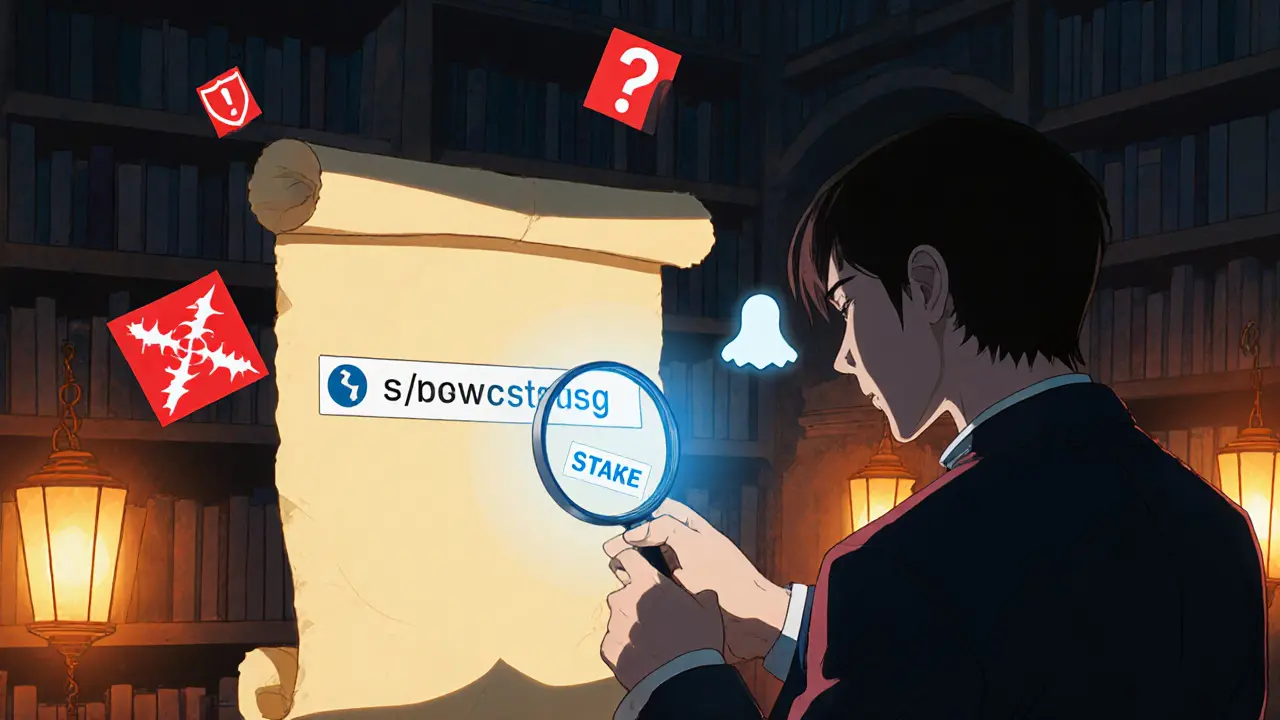Staking Reward Calculator
Verify Your Staking Token
Before calculating rewards, verify the token is legitimate. The article explains why there is no legitimate STAKE token. Use this tool only for established cryptocurrencies like Ethereum, Cardano, or Solana.
Staking Rewards Estimate
Quick Takeaways
- There is no widely recognized crypto asset called STAKE (STAKE) listed on major exchanges or analytics platforms as of October 2025.
- The word “stake” describes a process - locking tokens to help secure a proof‑of‑stake (PoS) blockchain - not a specific token.
- If you encounter a project named STAKE, treat it as an obscure or potentially fraudulent offering until you can verify its contract, team, and market data.
- Established PoS coins such as Ethereum (ETH), Cardano (ADA) and Solana (SOL) dominate staking markets, offering transparent reward rates and reputable validator ecosystems.
- Always perform on‑chain checks, audit reports, and community research before staking any unknown token.
Understanding the Word “Stake” in Crypto
When people talk about “staking” they are referring to a consensus mechanism. In a proof‑of‑stake network, validators lock up (or “stake”) a certain amount of the native token as collateral. In return they earn a reward for processing transactions and securing the chain. The reward can be a fixed annual percentage yield (APY) or a variable rate that changes with network conditions.
Staking is distinct from mining, which relies on computational power. Because it uses economic stake rather than energy‑intensive hardware, PoS has become the preferred model for newer blockchains seeking scalability and lower carbon footprints.
Is There a Dedicated Token Called STAKE?
Despite the popularity of the term, a token literally named STAKE (crypto coin) does not appear in any reputable market‑data source, major exchange listing, or blockchain explorer as of the 2025 reporting period. Searches across CoinMarketCap, CoinGecko, and on‑chain explorers return zero results for the ticker “STAKE.”
There are three plausible explanations for why someone might hear about a “STAKE coin”:
- Minor or experimental token - a tiny project with negligible market cap that flies under the radar of analytics platforms.
- Misunderstanding - conflating the staking process with a token name.
- Scam or copycat - a malicious actor creating a fake token to lure inexperienced users.
In every reputable 2025 report-Bankrate, Koinly, CoinLedger, Milk Road, and ZebPay-there is no mention of a legitimate STAKE token. Those reports list the top stakable assets (Ethereum, Cardano, Solana, Polkadot, Avalanche, etc.) and provide detailed APRs, validator requirements, and security assessments, none of which include STAKE.

How Staking Works on Established Networks
To illustrate what real staking looks like, let’s walk through the steps for three leading PoS coins.
- Ethereum (ETH) - Minimum of 32 ETH per validator node. Stakers earn roughly 2.5 % APR (as of Oct 2025). You can also pool smaller amounts via services like Lido or Coinbase.
- Cardano (ADA) - No hard minimum; you can delegate as little as 1 ADA to a pool. Average APR hovers around 4‑5 %.
- Solana (SOL) - Minimum of 0.01 SOL, making it the most accessible for casual users. Current APR is about 7.6 %.
Each network publishes its validator set, reward formula, and slashing penalties openly on‑chain. That transparency lets users verify that the rewards they receive are legitimate.
Major Staking Coins and Their Reward Landscape (2025)
| Coin | Minimum Stake | Average APR | Key Validators |
|---|---|---|---|
| Ethereum (ETH) | 32 ETH | 2.48 % | Rocket Pool, Lido, Prysmatic Labs |
| Cardano (ADA) | 1 ADA | 4.3 % | PoolTool, Adapools |
| Solana (SOL) | 0.01 SOL | 7.58 % | Marinade, SolStake |
| Polkadot (DOT) | 350 DOT | 15.31 % | Parity, ChainSafe |
| Avalanche (AVAX) | 2,000 AVAX | 9.2 % | Staked.Avalanche, Lido |
| Cosmos (ATOM) | 1 ATOM | 25.17 % | Cosmostation, Figment |
Notice that no entry exists for a token called STAKE, confirming its absence from mainstream staking ecosystems.

Red Flags to Watch for When a “New” Token Pops Up
If you stumble upon a listing for “STAKE” on a little‑known exchange, keep an eye out for these warning signs:
- No verified contract address - Reputable projects publish the contract on Etherscan, BscScan, or similar explorers.
- Lack of audited code - Security firms such as CertiK or Quantstamp usually release a public audit for genuine tokens.
- Anonymous team - Established projects disclose founders, advisors, and development roadmaps.
- Inflated promised returns - Anything promising double‑digit APY without clear risk disclosures is suspect.
- Absence from CoinMarketCap/Gecko - Most legitimate cryptocurrencies appear on at least one of these aggregators.
When any of these items are missing, treat the token as high risk and avoid staking until thorough due diligence is completed.
How to Verify a Crypto Token Before Staking
- Check the blockchain explorer - Find the contract address, view transaction history, and confirm the token’s creator.
- Search reputable data sites - Look for the token on CoinMarketCap, CoinGecko, or Messari for market cap, volume, and exchange listings.
- Read audit reports - Verify that a third‑party security firm has signed off on the smart‑contract code.
- Assess community activity - Active Telegram, Discord, and Reddit communities are a good sign of legitimacy.
- Use a trusted staking service - Platforms like Kraken, Binance, and Coinbase only support vetted assets.
Following these steps will protect you from accidentally locking funds into a phantom token like a non‑existent STAKE coin.
Bottom Line: What Should You Do About STAKE?
Given the lack of verifiable data, the safest answer is: don’t stake a token called STAKE until you can substantiate its contract, team, and market presence. Focus on proven PoS networks that have transparent reward structures, robust validator ecosystems, and widespread exchange support. If you’re curious about experimenting, use testnets (e.g., Goerli for Ethereum) where you can lock mock tokens without risking real capital.
Is STAKE (STAKE) listed on major exchanges?
No. As of October 2025, major exchanges such as Binance, Coinbase, Kraken, and KuCoin have no listing for a token with the ticker STAKE.
Could STAKE be a brand new token that just launched?
It’s possible a tiny project released a token named STAKE, but without an audit, verified contract, or presence on data aggregators it remains extremely risky. Treat it as speculative until proven otherwise.
How does staking differ from simply holding a token?
Holding (or “HODLing”) means you keep the token in a wallet without any participation in network security. Staking locks the token in a validator or delegation contract, letting you earn periodic rewards while helping secure the blockchain.
What are the safest PoS coins to stake right now?
Ethereum (ETH), Cardano (ADA), and Solana (SOL) are widely regarded as the safest, offering transparent reward formulas, large validator sets, and support from major exchanges.
Where can I verify a token’s contract address?
Use blockchain explorers: Etherscan for Ethereum‑based tokens, BscScan for Binance Smart Chain, and Polkascan for Polkadot assets. Always copy‑paste the exact address from the project’s official site.








Irish Mae Lariosa
July 11, 2025 AT 05:30 AMIt is astonishing how often novices conflate the generic term “stake” with the existence of a specific token named STAKE, and this article clears that up with commendable thoroughness. The author emphasizes that, as of October 2025, no reputable exchange lists a ticker STAKE, which aligns with the data from CoinMarketCap and CoinGecko. Moreover, the piece delineates the three plausible scenarios: a minuscule experimental token, a simple misunderstanding, or an outright scam, each of which warrants careful scrutiny. The discussion on proof‑of‑stake mechanisms versus mining is accurate and well‑structured, illustrating the energy‑efficiency advantage of PoS networks. By providing concrete APR figures for Ethereum, Cardano, Solana, and others, the article offers readers actionable insight into where legitimate staking opportunities lie. The inclusion of a detailed table comparing minimum stakes and average APRs further enhances the informational value, allowing quick reference. The author also wisely enumerates red flags such as missing contract verification, absent audits, anonymous teams, inflated returns, and lack of presence on major aggregators. This checklist serves as a practical tool for due‑diligence. Additionally, the step‑by‑step guide on verifying a token before staking is exhaustive, covering blockchain explorers, data sites, audit reports, community activity, and trusted services. The recommendation to experiment on testnets like Goerli is particularly prudent for risk‑averse users. Throughout, the tone remains balanced, avoiding sensationalism while warning against potential fraud. In summary, the article succeeds in demystifying the confusion surrounding a non‑existent STAKE token and equips readers with the knowledge to navigate the staking landscape safely.
Carolyn Pritchett
July 14, 2025 AT 02:57 AMHonestly, the whole STAKE hype is a textbook case of pump‑and‑dump theatrics. Anyone still peddling it deserves a reality‑check.
Cecilia Cecilia
July 17, 2025 AT 00:23 AMThanks for the clear breakdown. Staking genuine assets remains the safest route.
Ikenna Okonkwo
July 19, 2025 AT 21:50 PMReading this feels like a breath of fresh air in a market clouded with hype. When we focus on projects that openly share their validators and reward formulas, we not only protect our capital but also contribute to the collective security of decentralized networks. Remember, the true power of staking lies in its ability to align incentives, and that alignment shines brightest in transparent ecosystems.
Nick O'Connor
July 22, 2025 AT 19:17 PMIndeed, the emphasis on verified contracts, audit reports, and community engagement, all serve as essential safeguards; without them, one risks falling prey to dubious schemes, and thus, exercising due diligence becomes non‑negotiable.
Hailey M.
July 25, 2025 AT 16:43 PMWow, another “mystery coin” trying to get us all excited… 🙄 If you’re looking for a thrill, maybe try skydiving instead – it’s less likely to vanish overnight! 🚀💥
Vinoth Raja
July 28, 2025 AT 14:10 PMYo, the whole STAKE buzz is just another meme‑token circus, full of devs talking in buzzwords while the community chases moonshots that never leave the launchpad.
Matthew Theuma
July 31, 2025 AT 11:37 AMTotally get the vibe, bro - these on‑chain details can be sooo dense, but yeah, always double‑check contracts! 😎
Also, typos happen, just keep an eye on the address.
Jason Zila
August 3, 2025 AT 09:03 AMGot to say, the article’s methodical approach to vetting tokens is exactly the kind of assertive guidance the community needs.
Devi Jaga
August 6, 2025 AT 06:30 AMOh sure, “no STAKE token listed,” but that’s just the elite gatekeepers keeping us from the next big thing – classic contrarian vibes.
Schuyler Whetstone
August 9, 2025 AT 03:57 AMPeople need to stop glorifying any token just because it looks shiny – it’s a moral failing to ignore the obvious scams out there.
David Moss
August 12, 2025 AT 01:23 AMHonestly, the whole crypto‑exchange matrix is a façade; the real power resides in the hidden layers of control…; remember, they don’t want you to see the contracts!; keep your eyes peeled.
Pierce O'Donnell
August 14, 2025 AT 22:50 PMAnother token, another hype cycle – boring.